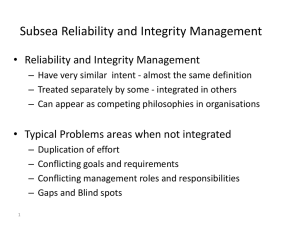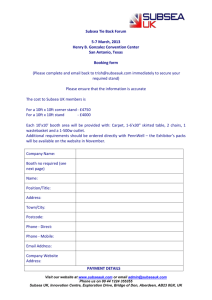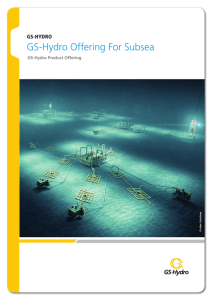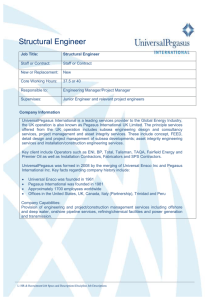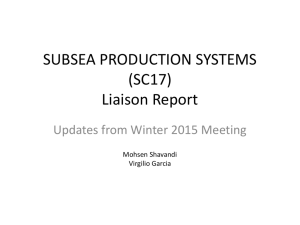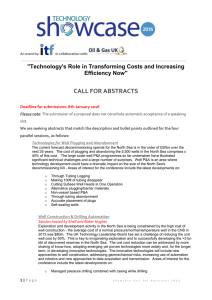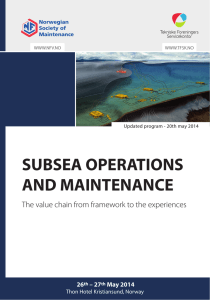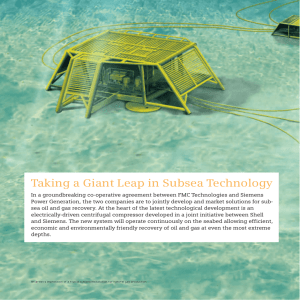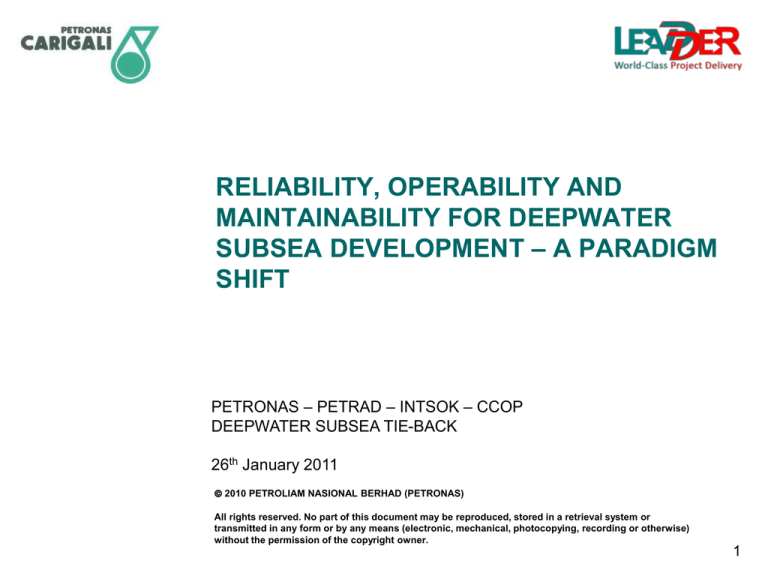
RELIABILITY, OPERABILITY AND
MAINTAINABILITY FOR DEEPWATER
SUBSEA DEVELOPMENT – A PARADIGM
SHIFT
PETRONAS – PETRAD – INTSOK – CCOP
DEEPWATER SUBSEA TIE-BACK
26th January 2011
© 2010 PETROLIAM NASIONAL BERHAD (PETRONAS)
All rights reserved. No part of this document may be reproduced, stored in a retrieval system or
transmitted in any form or by any means (electronic, mechanical, photocopying, recording or otherwise)
without the permission of the copyright owner.
1
Presentation Outline
1.
Presentation Objectives
2.
Concept revisited - reliability, maintainability
and availability
3.
Subsea Reliability & Integrity Management
System
4.
Summary
2
Presentation Outline
1.
Presentation Objectives
2.
Concept revisited - reliability, maintainability
and availability
3.
Subsea Reliability & Integrity Management
System
4.
Summary
3
Presentation Objectives
• To provide an overview of the difference in approach for
managing reliability, availability and operability for subsea
facilities.
4
Presentation Outline
1.
Presentation Objectives
2.
Concept revisited - reliability, maintainability
and availability
3.
Subsea Reliability & Integrity Management
System
4.
Summary
5
Reliability, Availability & Maintainability – concept
explained
How frequent equipment fails
“Mean time to failure”
How equipment’s functionality was
restored after a failure
“Mean time to repair”
Reliability
Maintainability
Availability
Equipment /
System Uptime
Operators strive for maximum availability as it is linked to business goals
6
Maintainability – 3 basic strategies. Which one is the
preferred for subsea?
Maintainability
1. Corrective Maintenance (CM) i.e
repair or replace when failure
occurs
2. Planned Preventive Maintenance
(PPM) i.e time based
maintenance/replacement
3. Condition based maintenance
(CBM) i.e monitoring the
performance and perform
maintenance/replacement when
condition deteriorates
Traditionally for topsides, the preferred approach is to do CBM followed by
PPM. CM is the least preferred strategy due to higher cost involved (including
7
production deferment cost)
For subsea, the most cost optimum strategy is the
least preferred strategy for topsides facilities
•
For subsea, the preferred
strategy is Corrective
Maintenance (CM) i.e repair or
replace when failure occurs
•
PPM and CBM are more
expensive to implement due the
high cost associated with
offshore operations and
infrastructure requirement
•
For subsea’s CM strategy, the
focus is on minimising the time
to restore failed equipment (e.g
retrievability)
However, Corrective Maintenance strategy itself when implemented is still not
cost efficient. There’s a need to eliminate potential failures when possible 8
For subsea, the main drive is to maximise equipment
reliability to achieve the targeted availability
How frequent equipment fails
“Mean time to failure”
How equipment’s functionality was
restored after a failure
“Mean time to repair”
Reliability
Maintainability
Availability
Focus is to maximise
reliability. i.e reducing the
frequency of failure
Equipment /
System Uptime
9
For subsea, the main drive is to maximise equipment
reliability to achieve the targeted availability
Reliability
Early Life
Failures
Failure rate
An expensive
learning curve
Can be
minimised by
good design,
fabrication and
testing
philosophy with
proven
installation
techniques
The main focus on extending life of equipment
before failure (failure free operating period) and
thus reducing the frequency of failures
Random Failures
These are the remaining through
life failures. Largely caused by
unforeseen external events or
usage conditions
Can be minimised by designing out
and operating to prevent all
foreseeable failures
Wear out
Failures
Decommission
before this
period
Failure Free
Operating Period
Goal
Anticipated Field Life
System Life Cycle
10
In order to achieve maximum reliability, the following
activities are undertaken
•
Removing early life failure
– Design it right
– Use of proven designs – frame agreement concept
– Use components with known high reliability
– Redundancy (in critical areas)
– Construct and manufacture it right - comprehensive testing regime
– Specifying proven installation techniques
•
•
Minimise random failures or their impact to production
–
Simplest possible designs/architecture- avoid complexity
–
Design for easy replacement
–
Good operating practice
Management of reliability activities are important to ensure they are done
efficiently- PETRONAS Subsea Reliability & Integrity Management System (S-RIMS)
Presentation Outline
1.
Presentation Objectives
2.
Concept revisited - reliability, maintainability
and availability
3.
Subsea Reliability & Integrity Management
System
4.
Summary
12
PETRONAS Subsea Reliability & Integrity Management
System (S-RIMS)
• A system to ensure all the
reliability activities are managed
properly specifically during the
design stage
TECHNICAL
PRACTICES
(WHAT)
• Reference Standard
– ISO 20815:2008 - Petroleum,
petrochemical and natural gas
industries – Production
Assurance and Reliability
Management
– API RP 17N - Subsea
Production System Reliability
& Technical Risk Management
RELIABILITY
TOOLS
S-RIMS
GUIDANCE
NOTES
(BEST
PRACTICES)
TECHNICAL
MANUALS
(HOW)
The S-RIMS system – the main philosophy
‘Leave no stone unturned’
Make every possible effort to check and
verify all equipment design, conditions,
functionalities, interfaces and performance
are in acceptable state before deployment
subsea.
The S-RIMS system – the main process
• Define
reliability &
availability
goals &
requirements
• Assurance
that the
requirements
have been
met
• Developing
plan for the
required
reliability
activities
DEFINE
PLAN
FEEDBACK
IMPLEMENT
• Implement
reliability
activities
Presentation Outline
1.
Presentation Objectives
2.
Concept revisited - reliability, maintainability
and availability
3.
Subsea Reliability & Integrity Management
System
4.
Summary
16
Summary
• Reliability and integrity is an important aspect of subsea
development project
–
To reduce the need of maintaining and repairing the equipment.
• Reliability and integrity achieved through:
– Attention to detail
– Managing failure through good design, quality in manufacture
(testing), flawless installation and operations control
17
THANK YOU

